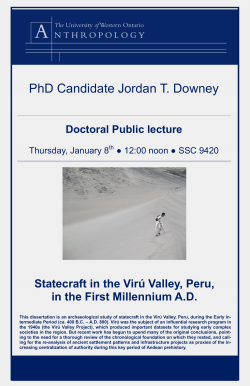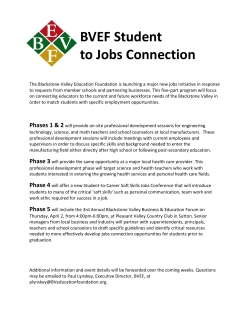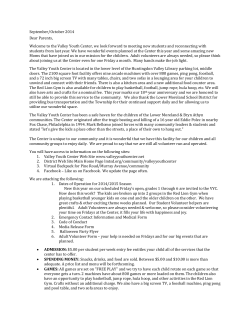
Current Newsletter - San Geronimo Valley Planning Group
March 2015 Volume 6, Issue 3 M ARCH N EWSLETTER SEWER PLANT AT THE GOLF COURSE Community Meeting Monday, March 30th at 7pm Lagunitas School Multipurpose Room Join us for a special presentation on a proposed wastewater treatment plant here in the Valley to service the needs of 300 Valley families in a concentrated area of Woodacre & San Geronimo. See the article below for more information . . . Valley Wide Septic Solutions Committee Report Committee Chair Dan McKenna introduced the Valley Wide Septic Solutions Committee to those in attendance at last month’s SGVPG monthly meeting. The Committee members include residents from throughout the Valley including the initial study area. Dan detailed the results of the Committee’s work over the past two years in a report to the general membership. The Committee has been studying a proposal by the Woodacre Flats Wastewater Group (WFWG) to build a community based sewage system for properties in Woodacre and San Geronimo. This proposal has been in the planning stages for over 5 years and was originally proposed to address properties whose septic systems are affected by the high water table in Woodacre Flats. Background Info In January of 2010, WFWG asked the Planning Group (PG) for its support in their efforts to secure County funds for a study to determine the best course of action to solve the septic issues. The PG endorsed the funding request with the proviso that any proposed solution would conform to the San Geronimo Community Plan. Questa Engineering conducted and completed the study. The study determined that a preferable solution for properties with failing septic systems was to move their leach fields off site rather than install alternative systems or renovate their systems on site. The study suggested a large community based sewage system be built on either Blue Berry Ridge, ironically where Valley Residents fought against a large water tank, or on the San Geronimo Golf Course. However, the level of community support did not equate to a financially viable community based system, so the project sponsors chose to enlarge the area by including portions of San Geronimo, as well as allow for residential development opportunities. At this point, the PG decided to investigate the issue and consider rescinding our support. Valley Sewage Plant? Based upon the current proposal as put forth by WFWG to the County their preferred project includes building a sewage/recycled water treatment plant with holding ponds on the Golf Course to service up to 300 homes in Woodacre and San Geronimo, allow for expanding homes by 500 sq. ft. or up to the median size home (whichever is greater) and legalizing existing nonpermitted structures. In order to fund the required environmental study, WFWG has raised approximately $38,000, but has also secured Public funds and staffing from the County totaling $157,000. They also have a proposed grant from MMWD totaling $50,000. In order to complete funding for the EIR they are actively seeking a grant from the State Water Resources Board for $75,000. All total, the EIR and feasibility study will total at least $290,000, of which at least $252,000 will be publically funded. Evaluation of Compliance with Community Plan Based upon how the project morphed into a complex sewage district project the PG established the Valley Wide Septic Solutions Committee to study the problem and determine if the present proposal is appropriate. As with any project or proposal reviewed by the PG we rely upon the San Geronimo Community Plan for guidance. Using the Community Plan we found the following discrepancies: 1. The proposed project is lacking in that it will not protect natural resources, as required in Sec. ER. – 1.2, because properties with failing systems that may be degrading the environment will continue to fail because functional systems will be allowed to join the sewage district displacing those with a true need. 2. The proposed project is lacking in that it will not protect or improve Creekside environment and water quality as required in Sec. ER.-2.1 and ER.2.1b because properties with failing systems that may be degrading the environment will continue to fail because functional systems will be allowed to join the sewage district displacing those with a true need. 3. The proposed project may affect the rural character of the Valley as required in Sec. CD – 1.2 through the development of new residential additions in a relatively small area of the Valley. 4. The proposed project may increase the housing density in a relatively small area of the Valley, which is in conflict with Sec. CD -1.7 of the Community Plan. 5. The proposed project does not encourage the use of Alternative Waste Systems as required by the Community Plan’s Sec. CD – 4.1. 6. The proposed project will change the use of the Golf Course, which is prohibited by Sec. CD – 7.3 without a new Master Plan Study. questions and concerns. The following Position Statement was presented to the group: • A revised EIR that includes options not only for those in the Woodacre Flats area, but for every Valley resident who wants to bring his or her wastewater treatment system into compliance with existing regulations. • Create an estimate of the total number of aging non-conforming systems, their general location, and compile a list of problem areas within the entire Valley. Particular focus should be placed on systems that lie within the Streamside Conservation Area (SCA). • Identify a variety of simple solutions with consideration given to on-site systems. • Study of the impact of modifying current County regulations to allow the use of modern or “experimental” systems and sub-surface drip solutions for solving septic problems as used in Napa, Sonoma and many other California counties. • Study if the model proposed for the Woodacre Flats and San Geronimo Flats area could be utilized in other areas of the State and has such a model (no threatened body of water, noncontiguous properties, and liability assumed by non-beneficiaries) been implemented previously • Implement a thorough search and identification of grants available to homeowners for repair or upgrades of existing on-site systems • Further study community leach field systems that are designed to lessen the impact to the surrounding community than the current proposals, one of which calls for large secondary treatment facilities in downtown Woodacre. • Study the impacts to the rural character of the San Geronimo Valley if special development rights are granted (i.e. 500 square foot additions) to a limited number of properties: - In the Woodacre, San Geronimo area only (current proposal). - Throughout the San Geronimo Valley (valley wide solution). Committee Position Statement - Within the SCA. In response to these conflicts with the Community Plan the Committee developed a position statement that attempted to capture outstanding • Study the impact of creating a ‘special real estate value’ to those properties participating in the proposed sanitation district with deed restrictions and opportunities for development as compared to properties not within the district. • Study the impact of eliminating existing leach fields not recharging the Valley aquifer. • Study the impacts from centralized treatment facilities, including visual blight in villages and unwanted smells during operation and maintenance, and the comprehensive impacts to the community during construction. • Study the impacts of multimillion gallon holding ponds adjacent to creeks and within the SCA, as well as potential catastrophic failures of sewer pipes crossing the creek. • Create more accurate estimates of monthly sewer utility homeowner costs for the operation, delivery of stated services, necessary future upgrades, and maintenance of any centralized sewer system. • Study the implications should the Golf Course ever close, or reduce water requirements below the current levels. • Study the hazards associated with the community sewer plant’s use and storage of toxic substances, including what sanitizing agents will be stored within the Valley and how the community will be safeguarded from associated hazards. • Define the 24/7 operational model for the community sewage plant and how public safety is maintained. • Confirm and explain the County’s commitment to indemnify Valley residents from liability associated through the construction and operation of a community sewage plant. • Confirm and explain the role the County will play as a fiscal agent, operational manager, and future capital investment manager for the Community Sewage system. Concluding Recommendation Before any more public money is committed to this project we need to verify what the problem is that we are trying to solve. A Valley-wide solution to septic issues that gives every homeowner an equal opportunity appears to be the best approach. Liza Crosse, a member of WFWG responded to the Committee’s concerns and thought a community dialogue would serve all concerned. However, it was recently learned that a funding request was placed on the County Board of Supervisors Agenda for March 3rd eliminating the viability for a community dialogue to occur prior to moving forward on an EIR. For more information on this matter follow the PG Newsletter and web site www.sgvpg.org and attend the next monthly meeting or stay connected via the Valley email list. Sunset photo by Eric Morey MARIN COUNTY SHERIFF DEPT. Lt Doug Pittman A few conscientious neighbors have installed their own private surveillance and security cameras to protect themselves from mail thefts, burglaries and other personal and property crimes. There are times when these cameras capture images of suspicious persons and/or vehicles related to crimes not directly associated with the owner(s) of the cameras but still offer valuable leads to crimes against their neighbors or nearby residents. Images like these are extremely helpful to law enforcement when investigating these types of crimes. If your neighborhood maintains this type of surveillance system please contact me via this website or my email address dpittman@marinsheriff.org in order that we could call you and see if your camera may have captured any valuable images that could benefit our investigations. Of course, this is completely voluntary and the decision to share these kinds of images is solely your choice. Please note . . . I am specifically seeking those neighborhood surveillance cameras that capture public areas and streets not personal home systems that focus on anyone’s own private property. If you have any questions, contact me. FINAL COHO UPDATE By Eric Ettlinger, MMWD Aquatic Ecologist The final update on Lagunitas Creek coho for the 2014-15 season is somewhat overdue because of some unusually late spawners. Last week we observed eight fresh coho in Lagunitas Creek, which is exceptionally late for a run that peaked in mid-December. Coho are typically seen spawning in February only when the rainy season is delayed, like last year. Given this year’s early rains the best explanation I have for the extended run is that the parents of these fish may have been late spawners. In 2012 the last coho of the season were seen spawning on Valentine’s Day. So, moving on to the postmortem…The best that can be said about this run is that it wasn’t smaller than the coho run three years ago, which is something. Our preliminary season total is 131 coho redds, or about 65% of average. This does not include spawning in Olema Creek or the tributaries to San Geronimo Creek, which are surveyed by the National Park Service and SPAWN, respectively. The marine survival rate of these fish was under four percent, which is well below the average of the last eight years. The picture was brighter for other species. We counted the highest number of Chinook salmon redds (23) in eight years and the highest number of chum salmon (3) in a decade. The steelhead run got off to a late start due to the exceptionally dry January, but is now in full swing. To date we’ve seen 70 steelhead redds, which is approaching average for late February. Finally, we saw the first Pacific lamprey of the season on January 29th. We typically see these native, cartilaginous fishes spawning in March, as we’re wrapping up our salmonid spawner surveys. Our AmeriCorps members took this great picture of a pair using their sucker mouths to pull rocks from their redd. Their eggs will hatch into worm-like ammocoetes that will spend as much as seven years filter feeding in the streambed. Then they will migrate to the ocean and find a larger fish to latch on to and parasitize. They aren’t able to navigate back to their natal stream like the salmonids do, but when they’re large enough they’ll let go of their host and follow the scent of juvenile lamprey pheromones to whatever stream they’re close to. Like the salmon, this is a one-way trip and they die after spawning. Lamprey will continue to spawn in Lagunitas Creek through the spring. RESOURCES FOR EMERGENCY NOTIFICATIONS For anyone interested in receiving information from emergency agencies sent to your email or cell, you can sign up here for alerts. It is a good way to keep informed during storms, road closures, etc. Just click on the orange Sign Up button on the right side of the homepage to register with whichever agencies you choose. http://www.nixle.com/ MMWD WATER REBATES • HIGH EFFICIENCY TOILETS – UP TO $100 • HIGH EFFICIENCY WASHERS – UP TO $50 • SMART IRRIGATION CONTROLLERS – UP TO $20/RESIDENTIAL VALVE http://www.marinwater.org/163/Rebates Hike to Stairstep Falls Nancy Hanson of Woodacre is a VIPP Park Volunteer coordinator for habitat restoration at Samuel P. Taylor State Park and is scheduling a special hike on Monday March 9th to Stairstep Falls in Taylor Park. She says,“ Please let me know if you plan to come so we can wait for you at the parking pullout for Devil's Gulch on Sir Francis Drake. We will meet there at 9:45, carpool into the Gulch at 10am and hike up Bill's Trail to the falls with our lunches and water bottles. We usually get back to our cars by 2pm or so, but you can always hike out early. It is an easy 1.2 mile walk to the falls.” “It will be a treat to be on that trail with no one else around. This trail is still closed to the public while the CCC takes a break from trail work during Spotted Owl nesting season. We'll view the trail work under way, check out the early spring flowers and weed forget-me-not seedlings at the falls area. We may go up again in late May and early June depending on the quantity of seedlings we encounter. I encourage you to take advantage of this opportunity to experience this trail again (or for the first time).” Contact Nancy at nphanson@comcast.net QUICK NEWS SHORTS • Marin Clean Energy prices for electricity continue to remain lower than PG&E and their customer base continues to grow. MORE QUICK NEWS SHORTS • Still waiting for news about the status of the Hedlund property in San Geronimo. Did Hedlund pay off that huge tax bill? Did one of the lien holders decide to take it on OR will it finally become the property of the County for us to protect and enjoy? • Marin County led Bay Area Counties in reporting wood smoke complaints (865) filed during Spare the Air Days last year. It led in reporting violations and ranked third in committing them. Sonoma had 48 violatons, San Mateo 33 and Marin 2l. • For those of you who have followed the Oyster Farm saga, you know that it closed on Dec. 31, 2014 after a 2-year legal battle. The latest – Cleanup came to a halt as harbor seal pups began to show up prompting Pt. Reyes National Seashore administrators to close an extended area through June 30 so the harbor seal colonies are left undisturbed. -Email Technician: Eric Morey • Newsletter Contributors: SC members; Chairpersons, PG members and Valley submissions. • Suggestions, comments and Valley Observations are welcome. Send to Co - Editors Please provide April Newsletter submissions by Thurs. April 2nd, 2015 PLANNING GROUP MEMBERSHIP Please urge a friend or neighbor to join us. $15 Single, $25 Family, $0 Over 65 and under 21 Make your check out to SGVPG and mail to: P. O. Box 57, Forest Knolls, CA 94933 * “This is the last place. There is nowhere else to go.” -- Lou Welch This line, always at the top of our agenda, is an excerpt taken from a poem by Lou Welch that was included in the extraordinary document “Can the Last Place Last?” which, in the late ‘60’s laid the ground work for the unique County Wide Plan that was adopted in1972 and created zoning, policies, codes & regulations that has served to preserve major parts of Marin from inappropriate development. SGV PLANNING GROUP NEWSLETTER • Co-Editors: Linda Nave lagunitaslinda@gmail.com and Jean Berensmeier, JeanBerens@comcast.net • Proofreader: Barbara Ures Mananita Blossoms, Lagunitas Ridge
© Copyright 2025










